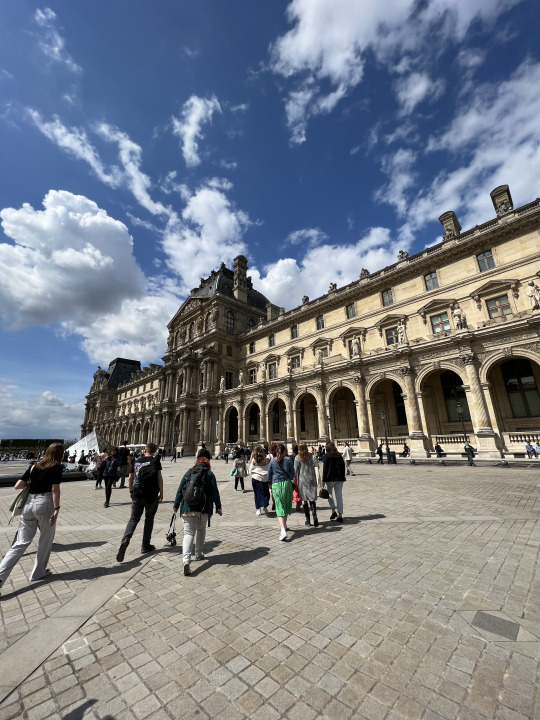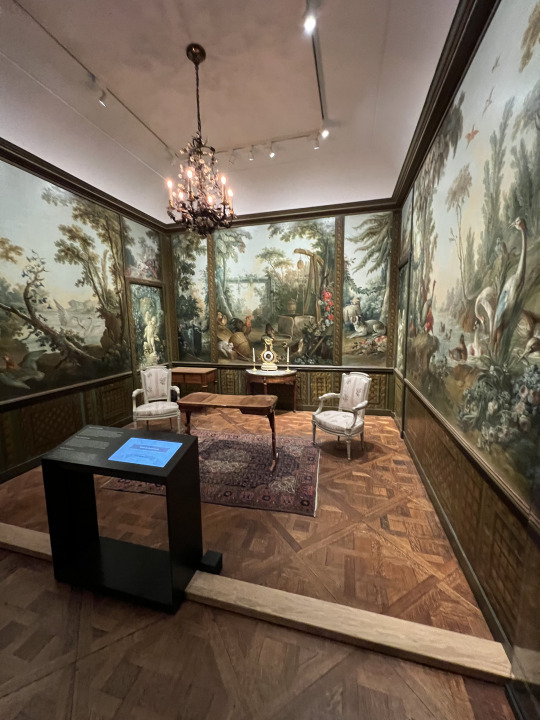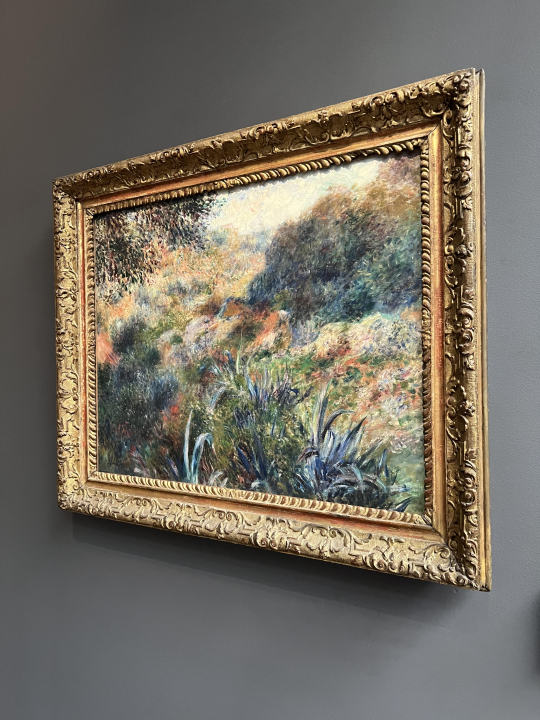Text
Entry #4: Religion
After visiting the Centre Pompidou and viewing some amazing contemporary art, I spotted a gorgeous old church nearby. After a bit of research, I found out that this church was called Saint Merry Church. It looks incredibly aged on the outside, with signs of water and wind damage on the stone façade. We ventured inside to see a beautiful gothic-style interior. The ceiling had the classic gothic ceiling, with crossing ribbing. The walls featured grandiose stained glass windows and large murals. In the middle stands a white marble statue of Jesus Christ on the cross, surrounded by angels.




While sitting in the church, I thought back to last Sunday. One week ago, I attended my very first Catholic Mass- all in French. While I have attended Methodist church services my entire life, I have never been to a Catholic service. This being said, the entire service was in French and Latin, both of which I can’t speak more than a few words of. This made my first Catholic service incredibly confusing. While I had been informed about some basic things by a few friends, I was still unsure what to expect. I was that a Catholic service required a lot of standing and sitting, that I wouldn’t be able to take communion, and that there would be a lot of singing. For some of my classmates, going to a Catholic service was very routine, and while they might not have understood everything due to it being in French, they understood the flow of the service. For me, on the other hand, this experience was incredibly new and educational. I had never been in a Catholic church for a service before, but I loved seeing all of the gorgeous stained glass windows, statues, murals, and organ pipes in the ones we’ve visited. The practices of a Catholic service were much more rigid and repetitive than what I was used to in a church setting, but it was interesting to see everyone following along in perfect rhythm with the Priest.
While on this trip, we also visited a mosque. I had never visited one before, and I found myself in awe of the beauty and intricacies of the tile walls. The outside area was filled with greenery and blue tiles, and it was incredibly peaceful. Seeing this mosque and learning more about the different rooms’ significances allowed me to have a deeper appreciation for the Islamic religion.
I grew up in a very culturally and religiously diverse city. We had many different Christian, Catholic, Jewish, Mormon, and Muslim places of worship in my hometown. Rather than the diversity impacting my religion, I rather found appreciation for everyones’ religious beliefs. Going to a public school with peers of many different religions allowed me some insight into others practices, cultures, and views. I believe this is part of what shaped me into who I am today, and I always strive to be accepting and open minded of what others believe in. Recently, I learned that the French believe in laicité, or secularism. This means that they believe in freedom of religion, but not in the same way that we do in America. They feel that the people should have freedom from religion, rather than freedom to express religion freely. This typically means that people are expected to keep their religious beliefs to themselves, and not push them on anyone else. While many are in favor of this idea, it doesn’t benefit everyone. This concept has been weaponized against those who practice the religion of Islam, due to the recent uprising of Islamophobia throughout the world. The women of the religion have been told that they are not allowed to wear any type of religious covering, such as a hijab or burka, in certain public places, as it contradicts the idea of laicité. Personally, I feel as though it is completely unfair to ban these coverings, and that the French should rethink their interpretation of laicité.
Word Count: 661
0 notes
Text
Entry #3: Paris Lifestyle
A few days ago, I visited the Jardin des Tuileries, or the Tuileries gardens. The Tuileries are public gardens, with many gorgeous flowers, fountains, and statues. The park has many benches, chairs, and spaces for people to wander or sit.

A picture of the beautiful flowers and statues.
At around 12 PM, a few friends and I took the time to grab a sandwich from a local cafe, and enjoy a lunch at the park. The space was incredibly packed, as noon is typically lunch time for local Parisians. Many people were sitting, eating, standing, and/or talking in the space. I felt very grateful for this public space, and loved seeing how many people were utilizing it. In the park, I observed many middle-to-older aged people. There were some younger children here or there, but for the most part this crowd in this park was made up of people who you would never see in a park mid-day in America. On a work day in the United States, there is absolutely no way that a park would be that packed.

The park was packed during lunchtime.
Something that I absolutely adore about the Parisian lifestyle (maybe just the French lifestyle in general) is the amount of time they sit, socialize, and relax each day. Their work-life balance seems to be much more of an actual balance than ours does. Besides the fact that an early work day in the States means that most working people must get up at an ungodly hour, there typically aren’t periods throughout the day where someone would be able to leave their job to go eat at a park. I know for a fact that none of my friends or family have been allowed this simple pleasure at their jobs. The French seem to be valued more as people in their working environments, whereas in America I have experienced a sort of “you’re a cog in the machine, get to work” type of attitude towards workers. In addition to the sorts of benefits that workers experience during the actual work day, most French workers also are allowed much more time off throughout the year. Americans may only get a few days off a year, whereas the French are expected to take weeks off. This is something that we could only dream of in a typical corporate-9-to-5-office job. Similarly, the French typically aren’t expected to check their emails nearly as consistently as those in America are. For example, weekends are typically off-limits for emailing. These differences are definitely something that I wish to see in the American workplace, but I do not expect any changes any time soon.
Learning about the differences between the French and American workplace certainly made me jealous, but was not surprising in the least. After all, the French have made a point throughout history to focus on liberty. Think about Marianne, the symbol of liberty throughout the French Revolution. Her portraits and statues reside all over Paris as a constant reminder of valuing the peoples’ needs first. Before there was a declaration of rights, there were three estates. These estates categorized people into the clergy, nobles, and commoners. The clergy and nobles had many benefits that the commoners did not. When the commoners decided they had enough, they created a constitution for the rights of the people. I believe that the French working class's long history of being taken advantage of in the workplace has contributed to their desire for boundaries and a healthy work-life balance.
Word Count: 572
0 notes
Text
Entry #2: Pere Lachaise Cemetery

Outside of the Pere Lachaise cemetery park.
After visiting the Pere Lachaise cemetery, I was overwhelmed by the feeling of many presences that I could not see. I am not a particularly religious person, but while wandering the abounding, winding streets of the cemetery, I was met with a sense of connection to the many people around me. I read many plaques depicting the stories of individuals’ lives, observed many tribute statues of stone, bronze, and granite, and saw many fresh bouquets of flowers left by grave sites. This feeling turned the phrase Lieux de Memoire into something that I had no longer merely read about, but instead experienced fully. Though I have visited many other Lieux de Memoires, or places of memory, on this trip, I felt the memories held in this space the strongest. Perhaps it was the notion that each of the hundreds of deceased people held in this cemetery had a lifetime of memories, or perhaps it was the people walking quietly around observing the stories that each grave had to tell. There is something so beautiful about this cemetery being a park as well, because it allows anyone to come experience these people's stories, and to build an appreciation for the lives that have come and gone. This cemetery/park is incredibly beautiful, and very different from anything I’ve ever seen in the United States.
There was an incredible amount of diversity between the graves at this cemetery. When we first arrived, the first type of tomb that I observed was one that almost resembled a stone shed. These tombs were tall and narrow, and inside there were typically pictures of the deceased person, flowers, or both. Though these tombs were abundant, some sat on the ground, and were very short and wide. These graves typically were made of granite, and had writing engraved in them. It is safe to say that the tombs that I observed were all incredibly different from the headstones I am used to seeing back home. While not every single tomb was intricate and ornate, they all were much larger than what is typically seen in American cemeteries.

An example of a few different tomb styles that can be seen inside the cemetery.
Before heading in, I saw that Frédéric Chopin’s tomb was included in this cemetery. Chopin is someone who I already have done much research on, as he was one of my favorite composers. I am a classically trained pianist, so I have played many of his pieces, and have a very deep appreciation for his work. When in the park, I had a very difficult time finding his tomb due to the vast amount of graves. After almost a half hour of searching, I finally found his tomb site. Chopin was known as the greatest musician of his time, and one of the greatest composers and pianists of all time. It has been said before that his technique could be rivaled by no other composer. I knew this all before going to visit his tomb, which made observing his resting place all the more interesting. Sitting atop a large rectangular base is a marble statue of a woman, who looks to be in morning. After some further research, I found that this woman is the Greek muse of music, known as Euterpe. In her arms she holds a broken lyre, which I found to be an incredibly moving analogy for the world of musicians grieving the loss of one of their most beautiful composers. While standing in front of this statue, I felt in awe of its beauty, but more so I felt overcome with a feeling of connection between me and the man who rested before me. A large group of people stood in silence as they took in the site, and felt the connection to this Lieux de Memoire.


Frédéric Chopin's tomb.
This experience was incredibly educational, and opened my eyes to the customs outside where I am from. It was interesting to experience such a strong feeling of connection, and begin to understand Lieux de Memoire in a deeper sense.
Paris Perfect. “A Guide to Père-Lachaise Cemetery.” Paris Perfect, September 30, 2020. https://www.parisperfect.com/blog/2018/03/a-guide-to-pere-lachaise-cemetery/.
Word Count: 660
0 notes
Text
Entry #1: Art Museums
When I was first reading the itinerary for this trip to Paris, I saw many visits to different art museums scheduled. First, we were set to see the Louvre, then the Musée Carnavalet, and finally the Musée d’Orsay. While I was excited about the prospect of visiting these museums and viewing many different types of art, I was also made a bit nervous by the idea of experiencing something I wasn’t familiar with. When it comes to art, I am incredibly inexperienced. It is honestly something that has always intimidated me, and the thought of standing next to my peers who are well-versed in the realm of art made me anxious. I enjoy looking at art, but it has always been just that to me; something pretty to look at.
At the first art museum we visited, the Louvre, I realized that art is not just something pretty to look at, nor just something to analyze visually; when pieced together, it gives great insight into the stories of the past. I had never walked through a museum with a guide, and so when my professors led the class to specific pieces to deconstruct the storyline of art during the French Revolution, I was captivated. Specifically, we learned about the techniques that painters used to create propagandistic art pieces. One example of this was when painters would paint Napoleon in pale, bright colors to not only draw the viewer’s eye to him, but to depict him in a Christ-like manner. On the other hand, painters could discretely spread the message about their true negative feelings about figures in power in a normal-looking painting, as David did in his painting, “The Coronation of Napoleon”.

The outside of the Louvre, which is a beautiful building.

Here is the Coronation of Napoleon by Jacques-Louis David.
Another art museum that we visited as a class was the Musée Carnavalet. While I still found this museum interesting, it was a very different style of museum than the other two we visited. It consisted of many rooms that were set up in the typical style of different time periods. Each room had many artifacts in it, as well as explanations for the items. Something I did notice at this museum was there is practically nothing pertaining to World War II in the room that would potentially cover that information. This was interesting insight into how the French feel about that particular time period, and confirmed the shame that they feel about their role in the war.

One of the rooms at the Musée Carnavalet.
Lastly, we visited the Musée d’Orsay. This museum is set up in more of a familiar style for me, and reminded me more of the set up of the Louvre. I loved the rooms that were dedicated to the different artists, mediums, and time periods. My absolute favorite was the Van Gogh section, which contained many of my favorite floral pieces, such as Fritillaries in a Copper Vase, his Sunflower pieces and Almond Blossoms.
One of the pieces that particularly caught my attention was “Algerian Landscape (The Ravine of the Wild Women)” by Pierre Auguste Renoir. At first glance, I was quite confused by this piece. This mental struggle to comprehend what I was looking at is what made this piece so interesting to me. After a close look, I could vaguely make out trees, grasses, and bushes. Because of the brushstroke style of the artist, the line of the objects in the painting is incredibly undefined, and it seems almost like looking at a landscape without glasses on. The grasses in the foreground of the painting are more defined than the rest of it, and these grasses helped me realize that what I was looking at was in fact an outdoor landscape scene. The free, loose brushstrokes used by the artist give the painting an unruly feeling. I can infer from the title of the piece that the artist truly wanted to capture the wild appearance of the landscape he was working with. When examining the color of the landscape, I see brighter oranges, greens, and whites in the middle strip of grasses, and darker greens, blues, and purples on the corners of the painting. Initially, I was wondering if these colors were implying a shadow on the grass, as you can see part of a tree in the upper left corner of the painting, but after a closer look, I believe that the differences in color rather show different types of vegetation in this landscape. Due to the fact that there is only a sliver of sky at the top of the piece, it seems to me that the landscape in this painting is on a slight incline, and the perspective is taken from the bottom of the hill. Figuring out the subject and perspective of an art piece typically doesn’t take as much work as it did with this painting, and I enjoyed deciphering it.

Algerian Landscape by Pierre Auguste Renoir.
Earlier, I mentioned that I didn’t know much about art before visiting Paris. I would typically wander aimlessly through museums, and while I would stop to look at the visually interesting art, I took close to no time to think about the historical significance of the work I was observing. Since starting this class, I understand that art can be pieced together to explain a historical event, and now that I have knowledge about the Elements of Art and Principles of Design, I have tools that I can use to decipher the true meaning and emotions of pieces.
Word count: 899
1 note
·
View note